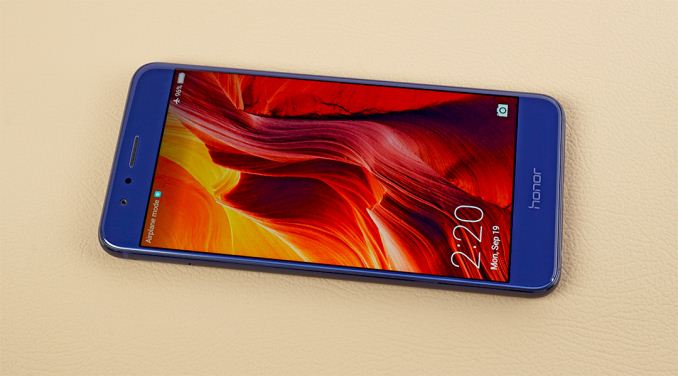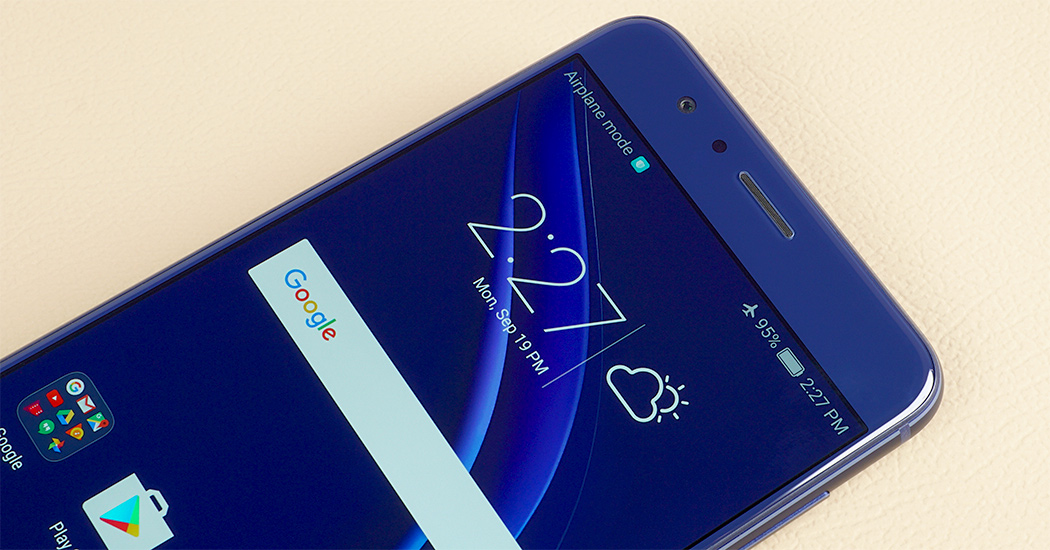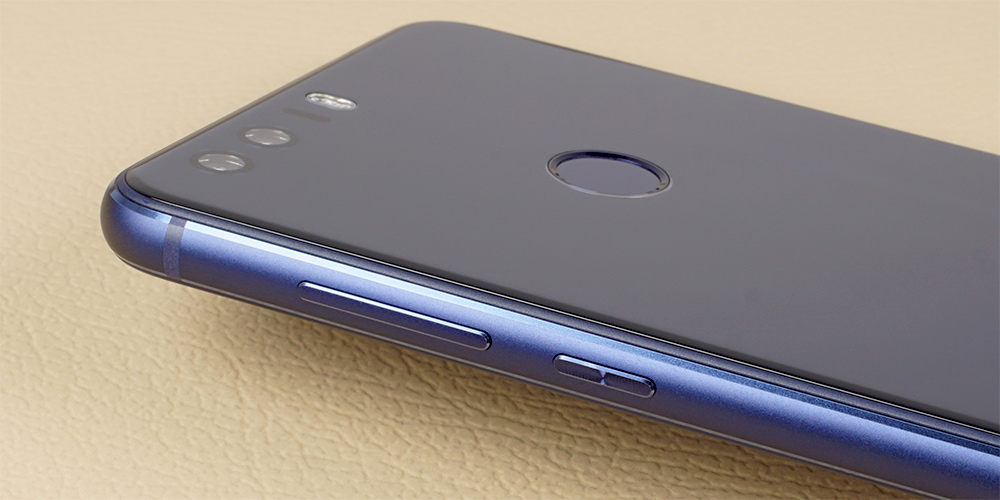The Huawei Honor 8 Review
by Matt Humrick on October 13, 2016 8:00 AM EST- Posted in
- Huawei
- Smartphones
- Mobile
- Kirin 950
- honor

Huawei’s smartphone branding strategy seems similar to many car companies. Toyota, for example, has the Lexus marque for high-end, luxury vehicles and the Scion marque that develops sporty, lower-cost vehicles with customization options targeted at millennials. Vehicles that carry the Toyota brand target mainstream consumers, covering a broad swath of the market with many different products.
Huawei’s Mate and P-series phones are analogous to Toyota’s Lexus brand, catering to the high-end of the market with premium performance and features, with the P-series specifically focusing on design and photography. In addition to its many other phones with varying features and price points, Huawei’s Honor brand parallels Toyota’s Scion, focusing on always-connected millennials. According to Huawei, 80% of Honor “fans” are aged 18-34, and delivering the performance, features, and style this demographic craves, while keeping cost within reason, is a significant challenge for Huawei.
After several years of declining sales, Toyota announced that it will discontinue the Scion brand in 2017. As an e-brand that’s distributed online without Toyota’s marketing budget and network of dealer showrooms, will Huawei’s Honor brand suffer a similar fate? For now sales continue to climb, with 40 million Honor phones sold in 2015, twice as many as the previous year. But Honor faces new challenges as it expands into new territories, such as the crowded and saturated US market, where it has little brand recognition.
Huawei’s first foray into the US smartphone market was with the Honor 5X, a lower-cost device with a well-balanced design. Encouraged by its initial reception, Huawei is back with a new device for the US—the Honor 8. While the Honor 5X hits a lower $199 price point, the Honor 8 costs twice as much but significantly improves performance and features. In many ways, it’s a restyled, less-expensive version of Huawei’s P9.
For starters, both phones use 5.2-inch 1080p IPS LCD displays. They also share similar dimensions (the Honor 8 is just a tad thicker and heavier) and the same 3000 mAh battery. The camera setup is the same too, with an 8MP sensor up front and dual 12MP sensors (one color and one black and white) around back, which I’ll discuss more later in the review.
| Huawei Honor 8 | Huawei Honor 7 | Huawei P9 | |
| SoC | HiSilicon Kirin 950 4x Cortex-A72 @ 2.3GHz 4x Cortex-A53 @ 1.8GHz Mali-T880MP4 @ 900MHz |
HiSilicon Kirin 935 4x Cortex-A53 @ 2.2GHz 4x Cortex-A53 @ 1.5GHz Mali-T628MP4 |
HiSilicon Kirin 955 4x Cortex-A72 @ 2.5GHz 4x Cortex-A53 @ 1.8GHz Mali-T880MP4 @ 900MHz |
| RAM | 3GB / 4GB LPDDR4-2666 | 3GB LPDDR3-1600 | 3GB LPDDR3-1866 |
| NAND | 32GB / 64GB (eMMC) + microSD |
16GB (eMMC) + microSD |
32GB / 64GB (eMMC) + microSD |
| Display | 5.2-inch 1920x1080 IPS LCD |
5.2-inch 1920x1080 IPS LCD |
5.2-inch 1920x1080 IPS LCD |
| Dimensions | 145.5 x 71.0 x 7.45 mm 153 grams |
143.2 x 71.9 x 8.50 mm 157 grams |
145.0 x 70.9 x 6.95 mm 144 grams |
| Modem | HiSilicon Balong (Integrated) 2G / 3G / 4G LTE (Category 6) FDD-LTE / TD-LTE / TD-SCDMA / WCDMA / CDMA (China only) / GSM |
HiSilicon Balong (Integrated) 2G / 3G / 4G LTE (Category 6) FDD-LTE / TD-LTE / TD-SCDMA / WCDMA / CDMA (China only) / GSM |
HiSilicon Balong (Integrated) 2G / 3G / 4G LTE (Category 6) FDD-LTE / TD-LTE / TD-SCDMA / WCDMA / CDMA (China only) / GSM |
| SIM Size | 2x NanoSIM (w/o microSD) (dual standby) |
2x NanoSIM (some models & w/o microSD) (dual standby) |
2x NanoSIM (some models & w/o microSD) (dual standby) |
| Front Camera | 8MP, 1.4μm, f/2.4 | 8MP, f/2.4, LED flash | 8MP, 1.4μm, f/2.4 |
| Rear Camera | 2x 12MP (color + monochrome), 1/2.9” Sony IMX286 Exmor RS, 1.25µm pixels, f/2.2, Laser AF + depth, HDR, dual-tone LED flash | 21MP, 1/2.4” Sony IMX230 Exmor RS, 1.12µm pixels, f/2.0, PDAF, HDR, dual-tone LED flash | 2x 12MP (color + monochrome), 1/2.9” Sony IMX286 Exmor RS, 1.25µm pixels, f/2.2, Laser AF + depth, HDR, dual-tone LED flash |
| Battery | 3000 mAh (11.46 Wh) non-replaceable |
3100 mAh (11.78 Wh) non-replaceable |
3000 mAh (11.46 Wh) non-replaceable |
| Connectivity | 802.11a/b/g/n/ac, BT 4.2 LE, NFC, IrLED, GPS/GNSS, USB 2.0 Type-C | 802.11a/b/g/n/ac, BT 4.1 LE, IrLED, GPS/GNSS, microUSB 2.0 | 802.11a/b/g/n/ac, BT 4.2 LE, NFC (EVA-L09 only), GPS/GNSS, USB 2.0 Type-C |
| Launch OS | Android 6.0 with Emotion UI 4.1 | Android 5.0 with Emotion UI 3.1 | Android 6.0 with Emotion UI 4.1 |
Both phones come with either 32GB or 64GB of eMMC NAND for internal storage, which can be augmented with a microSD card. The Honor 8, like the Huawei Mate 8, does use a different SoC from the P9. The four ARM Cortex-A72 CPUs in its Kirin 950 SoC only reach 2.3GHz versus the 2.5GHz in the P9’s Kirin 955, but this will not make a big difference in day-to-day use. Rounding out the big.LITTLE arrangement in both SoCs are four Cortex-A53 CPUs running at up to 1.8GHz and a Mali-T880MP4 GPU at up to 900MHz. While the T880 is currently ARM’s flagship, using only four shader cores limits peak performance. For comparison, the international version of Samsung’s Galaxy S7 comes with a Mali-T880MP12 GPU with three times as many cores. The Honor 8 does make the jump to LPDDR4 RAM, although it’s unlikely this will improve performance because the Kirin 950 and its quad-core GPU are not bandwidth limited.
In our Mate 8 review, the Kirin 950 SoC scored well in both peak performance and efficiency, a result of HiSilicon’s excellent implementation of A72 CPU cores on TSMC’s 16nm FinFET+ process. HiSilicon claims that the Kirin 955 SoC in the Huawei P9 is even more power efficient than the 950, so it will be interesting to see how the Honor 8, with the same size battery and screen, compares in our battery life tests. Along with the efficient SoC, the Honor 8 also includes the i5 sensor hub that further reduces power consumption by offloading specialized tasks such as voice recognition, step calculation, and mp3 music decoding to its ARM Cortex-M7 processor.
Huawei also includes some software features for further stretching battery life. There are three different power modes—Performance, Smart, and Ultra—that adjust the CPU DVFS curves and tailor network usage. The Smart mode is selected by default and promises a sensible balance between performance and power. There’s also the ROG power saving mode that limits screen resolution to 720p, reducing the GPU’s workload and the amount of data transferred over the memory bus. The power firewall feature (off by default) detects “power-intensive” background apps and automatically closes them.
The Honor 8 comes with Bluetooth 4.2 LE and 2.4GHz/5GHz 802.11a/b/g/n/ac Wi-Fi courtesy of the Broadcom BCM4345 (the same solution found in the P9), but does not support 2x2 MU-MIMO like the Galaxy S7. It also comes with NFC, which is absent on all but one version of the P9, and an infrared LED for universal remote control duties, another feature missing from the P9. On the bottom is a USB 2.0 Type-C port for data transfer and fast charging.
Residing inside the Kirin 950 SoC is a HiSilicon Balong baseband processor supporting Category 6 LTE speeds—up to 300 Mb/s down and 50 Mb/s up with 2x20 MHz carrier aggregation and 64-QAM on the downlink.
| Frequency Band Support | |||
| Carrier (Country) |
AT&T / T-Mobile (US) |
Telecom (China) |
Mobile / Unicom (China) |
| FDD-LTE | B1 / B2 / B3 / B4 / B5 / B7 / B8 / B12 / B17 / B20 | B1 / B3 / B4 / B7 | B1 / B3 / B7 / B8 |
| TDD-LTE | - | B38 / B39 / B40 / B41 | B38 / B39 / B40 / B41 |
| GSM | 850 / 900 / 1800 / 1900 | 850 / 900 / 1800 / 1900 | 850 / 900 / 1800 / 1900 |
| WCDMA | B1 / B2 / B4 / B5 / B8 | B1 / B2 / B4 / B5 / B8 | B1 / B2 / B5 / B8 |
| CDMA | - | BC0 | BC0 |
| TD-CDMA | - | B34 / B39 | B34 / B39 |
The version sold in the US works on AT&T’s and T-Mobile’s networks, and it also supports the necessary frequencies to work in Europe. The Chinese models include support for the requisite CDMA2000, TD-SCDMA, and TD-LTE frequencies used by the national carriers.
The Honor 8’s SIM tray holds one NanoSIM card and either a second NanoSIM or microSD card. When using two SIMS, it functions in Dual-SIM Standby mode with the second card (user selectable) supporting only GSM voice calls.
There’s two configurations available for sale in the US: The 4GB / 32GB version costs $400, and the 4GB / 64GB version costs $450. Both versions are available in black, white, blue, and gold colors from select online retailers. Chinese customers get a third, less-expensive option with 3GB of RAM and 32GB of storage for ¥1999 (~$300).













95 Comments
View All Comments
Matt Humrick - Friday, October 14, 2016 - link
That's a good point. The Smart mode selectively reduces screen brightness when using specific apps. It does not alter screen brightness for the PCMark test, which is one reason why there is not a bigger gap between it and the Performance mode; however, it does drop brightness from the calibrated 200 nits to about 100 nits when using the Chrome browser, which would increase the battery life in our web browsing battery life tests (these were run in Performance mode).prku - Friday, October 14, 2016 - link
Honor 8 is not a dual-standby dual sim phone. Please check again. it is supposed to have Dual Sim Full Active (which is a major selling point). DSFA is supposed to be present in all but Indian variations of the Honor.randomlm - Saturday, October 15, 2016 - link
Thanks for the nicely written, well balanced and non-biased review matt. This is the standard I've come to expect from anandtech that imo, some other reviewer on this site hasn't been delivering, especially on the camera portion of the review.Of course, entirely just my opinion
Feegenie - Saturday, October 15, 2016 - link
Fair.........jvl - Saturday, October 15, 2016 - link
"It’s a bit unfair to point our fingers solely at the OEMs and carriers, of course, because it was Google that created this mess and, ultimately, only Google can clean it up."What.
lagittaja - Saturday, October 29, 2016 - link
Do you even Android? Version distribution. Google can't force OEM's or carriers to update the devices.Even Android N's "auto update" doesn't really fix anything.
Why would the carrier or OEM keep updating the devices if they can just drag their feet on the ground making the update process as slow and painful as possible or just flat out not update them? Even once? The consumer will just buy a new device anyway.
Between 29th Aug and 5th Sept, of all the devices "phoning home" to Google a whopping 81.3% were running Android Lollipop 5.1 or older version.
If you take Lollipop out of the equation, 46.3% of the devices were running KitKat 4.4 or older.
If you take KitKat out of the equation, still almost 20% of the devices were running Jelly Bean 4.3 or older..
https://developer.android.com/about/dashboards/ind...
http://www.infoworld.com/article/3072591/android/g...
Google even tried to downplay the issue during May I/O event saying "it's not fragmented".
https://data.apteligent.com/download-report?report...
Yeah, that looks SO much better... 80%+ of devices being used are running Lollipop or older. A third of the devices being used are running KitKat or older..
And saying yeah, well only KitKat, Lollipop and Marshmallow matter because reasons and hey look at that 92% of devices being "used" are running Android OS's that "matter" and oh hey in contrast to iOS there's only iOS8 and iOS9 that matter and oh hey that comprises 97% of the iOS traffic. We're just as good as Apple! Yey us!
Uhm no.. Apple keeps it tidy because they have CONTROL...
iOS 9 only runs on devices that are from 2011 or older.
iOS 10 only runs on devices that are from 2012 or older.
Google has no control what so ever of Android devices that are not made by them.
Bloody hell, there's still Android devices sold new that run KitKat. And guess what, most of them are not going to receive a single damng update because the OEM doesn't give a flying fuck about it.
Look at Apple, look at what devices they sell. Guess what, they run iOS 10 or are just waiting to be turned on so they can nag you that there's a pending update.
With Android Nougat Google should have grabbed the "bull by the horns" and just fix the God damn problem.
They should have made a way for them to be able to at least deliver the critical security updates to the devices "automagically" no matter what sort of customizations OEM's or carriers have done.
I don't have the faintest idea of how that could be done but it's the least that needs to be done.
P.S. I'm an Android user and always will be. I don't like Apple's devices or their OS but I like how good control they have over their devices.
phuzi0n - Sunday, October 16, 2016 - link
Is this a phone review or a car review? We could do without all the car analogies in the first three paragraphs.Badelhas - Sunday, October 16, 2016 - link
I hate these Chinese UI skins which are iPhone iOS imitations. But that's just me.nkuehn - Friday, October 21, 2016 - link
Matt, did you also do testing on the Cellular Performance? Anandtech is famously good at really testing and not just testin, but I'm totally missing this part. I'm asking because some other reviewers had serious issues with the LTE performance of the device, losing LTE connection in well covered area etc.Maybe partner with people like http://cellularinsights.com/ - they have the testing hardware for cell that you have for displays and all the other stuff.
Savanah - Thursday, October 27, 2016 - link
I am so glad I went for the Moto Z Play instead of the Oneplus 3. It has a premium build quality, great display, awesome battery life, buttery smooth performance and decent cameras. It also excels in areas we tend to take for granted like call quality and signal retention. And to top it off it is bound to get fastest Android updates of any non Nexus/Pixel device. What else can you wish for in a $350 smart phone?